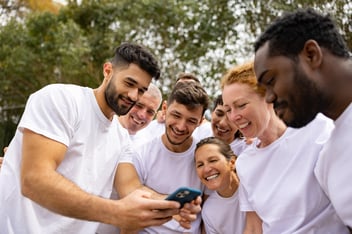Did you know that the shelf life of a Tweet is only three hours? That means that you need to make your posts both engaging and sharable, while spending a minimal amount of your own resources (after all, you don’t want to spend 10 hours on something that people are only likely to see for three). Whether you’re new to Twitter or looking to revamp your strategy, these five tips will help improve your Twitter strategy in no time!
1. Post Regularly, and on Multiple Channels
If your nonprofit, university, or business is producing quality content, tweet it regularly! If you post consistently, your followers will expect your articles and keep an eye on your feed. You should also direct the people who land on your blog back to your social media channels. You can accomplish this by linking your account, or by directly embedding Facebook or Twitter posts into your content. This help article will teach you how to embed a Tweet on your website or blog.
2. Share Other People’s Content
Especially in the nonprofit world, you may find that you don’t always have the time to publish original content—and as it turns out, you shouldn’t need to. In fact, it’s likely that most of your Twitter followers would prefer to see you post curated, relevant content from other people. There’s something called the 60-30-10 rule, where 60% of your Tweets should share relevant, third-party content, 30% should offer original content (such as a blog), and 10% should directly promote your organization or brand. If you follow this rule, you are more likely establish yourself as a reliable source in your industry, without annoying your fans.You can even start using a news aggregator to stay up-to-date on industry-related news that you can post on your own Twitter account.
3. Shorten Your Links
Take a look at our Tweet below. Notice how the link to our whitepaper on Millennial engagement looks a bit unwieldy? You can actually use a URL shortener to clean up your links and make them more visually appealing to your followers.
Great visual! Read our in-depth study of #Millennial #Engagement https://t.co/RNXOJNlTv4 https://t.co/toro6LZekj
— Galaxy Digital (@GalaxyDigital) February 6, 2017
Should you #donate your specialized skills to a #nonprofit ? Read more about skills based #volunteering on our blog👇https://t.co/zeLDlKJ5UE pic.twitter.com/UTWLJwkuEr
— Galaxy Digital (@GalaxyDigital) February 9, 2017
Now look at the above example where we tweeted an article link on Skills Based Volunteering. See the difference? I personally like Bitly’s URL shortener the most because it’s free and simple to use. Bitly can also collect live click data, geographical location, and the webpage where the link was clicked. You can use all of this information to learn where your followers are from, what time they’re most active, and what they’re most interested in. This information will be invaluable as you decide what content to create and share with your followers. Another benefit of a URL shortener is that clean, clickable links promote sharing. Keep in mind that a link, whether it’s shortened or not, will always take up 23 of your 140-character limit on Twitter.
4. Emojis Are Fair Game 👍👍
In 2016, people increased their use of emojis in marketing messages by 20% month over month! While emojis use only one character of your 140-character limit, they can be used to convey entire ideas or even sentences. They offer a pretty cool, fresh way to grab attention and set yourself apart in a cluttered news feed. Emojis have even been shown to increase engagement! According to one experiment by Wordstream, Twitter ads with emoji characters received 25.4% higher engagement than those without. Here are some other great benefits of emoji use on Twitter.
5. Know How to Use Hashtags Effectively
People who are new to Twitter tend to think that more hashtags equal more activity. But it turns out that if you use more than two hashtags, you’ll actually experience a 17% drop in engagement. So keep to two hashtags per tweet that are specific to your organization. If you need inspiration, check the Trending box on your home screen and join relevant conversations. You can also create your own unique hashtag for your nonprofit and/or campaign. For instance, Meals on Wheels uses #LetsDoLunch and AmeriCorps VISTA uses #IAmVISTA. By creating your own unique hashtag, you can track mentions over time. And don’t just post it once; use it regularly as you post and share content with your followers. They’ll notice it, recognize it, and maybe even share it.





